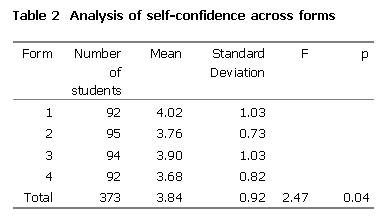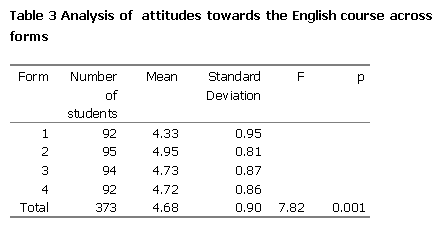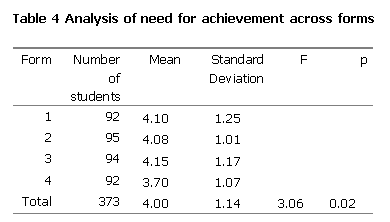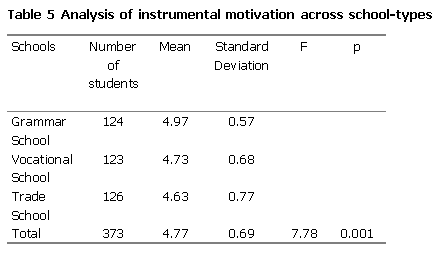Fehér Endre
Research in the field of language pedagogy and the everyday experience of language teachers show that motivation plays a crucial role in foreign language learning. Motivation ensures that learners invest sufficient effort in the long and tiresome process of acquiring a foreign language. Research in this field has also shown that motivation can be made up of various components (Clément, Dörnyei & Noels, 1994; Dörnyei, 1990; 1996; 1998; Gardner, 1985) and that teachers can influence their learners’ motivation in a positive direction (Dörnyei & Csizér, 1998; Nikolov, 1999). Therefore, in order to enhance students’ motivation and thereby contribute to successful language learning, teachers need to know what factors play a significant role in motivating Hungarian learners to acquire a foreign language.
As a teacher of English in a secondary school, I have come to realise that, despite the fact that motivation is a well-researched field in Hungary (e.g. Dörnyei & Csizér, 1998; Dörnyei, Nyilasi & Clément, 1996; Nikolov, 1999), no studies have been conducted that examine the secondary-school student population. To date, research on motivation has only concentrated on primary school students in Hungary. Therefore, we do not know how the motivation of students in grammar schools, vocational secondary schools and trade schools differs. Neither do we have information on the difference of motivational factors in grades 9 to 12 of secondary school.
In order to shed light on the various factors in motivation in various
types of secondary schools and in various age groups, I conducted a survey
in November 1998 with the co-operation of three different types of secondary
school in Újpest, the district where I teach. As a considerably
high number of students (373) filled in the questionnaires, the results
can give us some information on secondary school students’ motivation in
learning English at least in this small area of the country.
Before discussing the research project in detail, I will provide
a brief overview of the components of motivation. Next a detailed description
of the method of research will be given, which will be followed by a discussion
of the results and their implications.
Components of motivation
The overview of the components of motivation presented here will be based on Dörnyei’s (1998) model (for the discussion of other models of motivation, see Dörnyei, 1998). In this model there are two major types of motives at work in the case of foreign language acquisition: general motives and situation specific motives. General motives include (1) instrumental motivation, (2) integrative motivation, (3) need for achievement, and (4) attributions about past failures.
Instrumental motivation means that the motives for learning a foreign language are associated with the pragmatic, utilitarian benefits of attaining good language proficiency. Integrative motivation occurs when students learn the language of a community they value highly in order to facilitate communication or identify with the culture of the second language (L2) group.
While integrative motivation and instrumental motivation are related to the purpose of learning a language in general, in Dörnyei’s (1998) model need for achievement is associated with the personality of the learner. Need for achievement entails the desire to achieve a certain goal, which is in this case, to become a proficient L2 speaker. Finally, attributions about past failures is also considered a highly important factor in motivation to learn L2, since the learner’s past language learning history, especially learning failures, have an effect on the learner’s present learning achievement.
Situation-specific motives include: (1) appraisal of the learning group, (2) appraisal of the teacher, (3) appraisal of the language classes and teaching material, and (4) linguistic self-confidence, (5) language use anxiety and language class anxiety, and (6) quality and quantity of language contact (Dörnyei, 1998). Appraisal of the learning group is related to group dynamics; namely, to how students behave as members of a language learning group. Appraisal of the teacher shows the students’ perceptions about their teachers, whereas appraisal of the language classes and the teaching material reveals students’ attitude to what happens in the language classroom. Finally, linguistic self-confidence gives an indication about learners’ perception of their own language competence and success in learning the language.
Method
To investigate the various factors that motivate students to learn L2, three secondary schools in Újpest were compared. 373 students participated in the research. In order to gain comparable results, it was important that the quality of teaching in the three selected schools should be similar. Accordingly, a grammar school (hereinafter Grammar School), a vocational secondary school of economics and foreign trade (hereinafter Vocational School), and a trade and secondary school of electric engineering (hereinafter Trade School) were chosen. At each school, four forms with approximately 30 students in each form were surveyed. In the Trade School, classes that attended the four-year long educational programme were selected.
At the Grammar School, languages are given a high priority, and German, English, French, Russian and even Japanese are taught. In the Vocational School, which specialises in foreign trade and economics, the teaching of foreign languages has always been considered highly important, so students study French and Russian as well as English and German. The Trade School specialises in electrical engineering and students in the four-year programme study only one language, either English or German.
The questionnaire that was used for the research was originally composed by Dörnyei Zoltán and was identical with the questionnaire administered to the participants of the ELTE-Leeds Research Project sponsored by the British Council (permission to use the questionnaire was obtained). The questionnaire consisted of 45 questions, in which students had to rate on a 6-point scale the extent to which they agree with various statements. For examples of the questions see Table 1 (based on Dörnyei & Kormos, forthcoming). The questionnaire aimed to measure eight components of motivation: integrative and instrumental motivation, attitudes towards English speakers and towards the English course, language-use anxiety, linguistic self-confidence, effort, and need for achievement.
The questionnaire was administered during the first term of the 1998-1999 academic year. The data was processed using the Statistical Package for the Social Sciences (SPSS-X) with the help of the thesis supervisor. To establish differences between groups, the statistical procedure of one-way analysis of variance and the Scheffé-test were used. These statistical methods can reveal whether the various groups of participants show significantly different motivational patterns.

Results and discussion
The results of the study generally indicated that secondary-school students in these schools in Újpest were highly motivated to learn English. Except for linguistic self-confidence and language use anxiety, all the other variables investigated showed values above 4 on a 6 point-scale, where the maximum value was 6. This suggests that the participants’ overall motivation to study English was relatively high. In comparison with Dörnyei et al.’s (1996) study, we can also conclude that these secondary school students’ motivation is quite similar to the motivation of primary school students. Out of the eight components of motivation that were investigated in the study, two components - language use anxiety and attitude to English speakers - were influenced neither by the participants’ age nor by the type of school they attended. The discussion of the findings below is going to focus on the variables that were affected either by school-type or by age.
The first motivational scale that showed a significant difference among students in different forms is self-confidence. As mentioned above, the purpose of this scale was to measure the students’ confidence that they could fulfil their language goals, perform the tasks required of them competently, and achieve good results. The results showed that there was a significant difference between the students in the first year and the fourth year irrespective of the type of school (see Table 2). First year students seemed to be quite confident that they would do well in English. By the fourth form, however, learners’ self-confidence seems to have dwindled, which might be due to a number of factors. By this time, they had been learning English for four years, and might have come to a more realistic or perhaps even to a forlorn view of how much more they would need to learn to become proficient speakers. Fourth year students might have also felt that the opportunities to improve their knowledge were becoming fewer, since after graduation they would have to pay if they wanted to continue their English studies.

The second motivational scale where differences between students in various forms could be found was attitudes towards the English course (see Table 3). The results indicated that students in the first year had significantly less positive attitude to the course than students in the other three forms. This finding seems to suggest that students need time to get used to the way English is taught in the secondary school and to the new materials used in classes.

The third motivational component that was affected by the age of the participants was need for achievement. The statistical analyses revealed that need for achievement in the fourth form was significantly lower than in the other three forms (see Table 4). This indicates that fourth year students had a lower inner drive to learn English. The reason for this might be that these students begin to work harder in preparation for graduation, and my experience also suggests that they judge English as less important than the other school subjects.

As regards the various types of school, the first motivational factor that showed differences was instrumental motivation; that is, the perceived pragmatic benefits of English proficiency. The results showed that grammar school students had significantly higher instrumental motivation than participants from the vocational and trade schools (see Table 5). It would seem that grammar school students saw English proficiency as having greater importance in their future career. The reason for this might be twofold: on the one hand, they might be more familiar with the importance of speaking foreign languages in our globalized world; on the other hand, graduates of grammar-schools might be more likely to take on jobs where a knowledge of English is required than graduates of the other two schools, and they might have more opportunities to use English when they travel or meet other speakers of English in Hungary.

Similarly, it was revealed that grammar school students had a greater wish to learn about English speaking people and their cultures than participants from the vocational and trade schools (see Table 6). This result is not surprising, since grammar schools generally place more emphasis on the teaching of the humanities including teaching culture than the other two types of schools. In the vocational and trade schools several additional technical subjects are taught, and instead of focussing on cultural issues, teachers tend to present ESP materials in the English course.

The results concerning the motivational factor of effort, showed that both grammar and vocational school students invested, or planned to invest, more effort in acquiring English than trade school students (see Table 7). In the case of grammar school students, this difference is understandable, as learners who believe that the knowledge of English could be important in their future lives and who are interested in the target culture, are likely to devote more time and energy to learning the language. It is interesting, however, that vocational school students were also willing to invest a lot of effort into attaining proficiency in English, despite the fact that they do not have very high instrumental motivation and do not show outstanding interest in English culture, either.

Conclusion
The research findings discussed in this paper show that motivation played a highly important role in learning English in the secondary schools investigated regardless of which form and type of school students studied in. The overall picture concerning secondary school students’ motivation was very positive, as the participants generally showed a high motivation to learn English. Nevertheless, the results suggest that teachers should pay special attention to motivating fourth year students not to give up learning the language. English teachers in vocational and trade schools should also try to raise students’ awareness of the practical benefits of speaking English. The findings of the study highlight that secondary school students’ linguistic self-confidence (especially in the 4th form) and language-use anxiety should not be neglected either because low linguistic self-confidence and high language-use anxiety might prevent students from communicating successfully in the target language.
Notes
- This paper is an abridged version of the author’s unpublished M.A. dissertation. (Fehér, E. 1999. Motivation in learning English at three secondary schools in Újpest. Berzsenyi Dániel Teacher Training College, Szombathely/Budapest.) (back)
Clément, R., Dörnyei, Z., & Noels,
K. A. (1994). Motivation, self-confidence, and group cohesion in the foreign
language classroom. Language Learning, 44, 417-48.
Dörnyei, Z. (1990). Conceptualizing motivation in
foreign language learning. Language Learning, 40, 46-78.
Dörnyei, Z. (1996). Motiváció és
motiválás az idegennyelvek tanításában.
Modern Nyelvoktatás, 4, 3-21.
Dörnyei, Z. (1998). Motivation in second and foreign
language learning. Language Teaching, 31, 117-135.
Dörnyei, Z., & Csizér, K. (1998). Ten
Commandments for motivating language learners: Results of an empirical
study. Language Teaching Research, 2, 203-229.
Dörnyei, Z., & Kormos, J. (forthcoming). The
role of social and individual variables in task performance. Language Teaching
Research.
Dörnyei, Z., Nyilasi, E., & Clément,
R. (1996). Hungarian school children’s motivation to learn foreign languages:
A comparison of five target languages. novELTy, 3 (1), 6-16.
Gardner, R. C. (1985). Social psychology and second language
learning: The role of attitudes and motivation. London: Edward Arnold.
Nikolov, M. (1999). “Why do you learn English?” “Because
the teacher is short.” A study of Hungarian childrens’ foreign language
learning motivation. Language Teaching Research, 3, 33-56.
Fehér Endre teaches English at Berzeviczy Gergely Secondary School, Budapest.